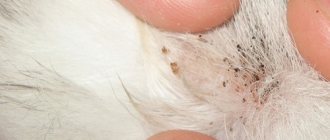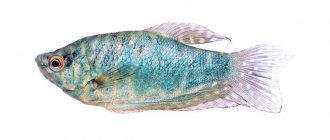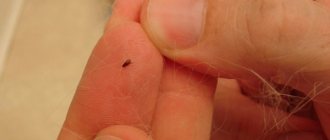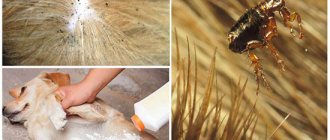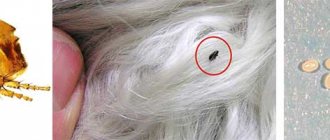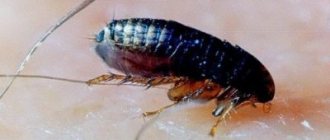Fleas are one of the most common parasites on the planet. They can be found in the driest and hottest regions and even in Antarctica. There are a huge number of species of these blood-sucking insects, but dog fleas pose a particular problem for dog owners, who consider the blood of our little brothers the best delicacy.
Infection with them is simple and danger awaits even domestic decorative dogs that do not go outside and do not come into contact with other animals. But getting the tenants out can be difficult.
Only constant prevention with the help of special medications and constant high-quality cleaning of the premises in which the dog lives can protect it from new tenants.
What do fleas look like on dogs?
Dog parasites have a similar structure to other types of fleas. They are small in size, which in rare cases can reach 5 mm. Insects can be colored red, brown or black. They have a flattened shape on the sides and developed hind legs, allowing them to jump great distances. The body is covered with a dense shell and hairs, which allow the insect to be held in the fur of animals. Other types of external blood-sucking parasites can live on a dog’s body:
- Felines;
- Human;
- Rat.
The division is very arbitrary, since an insect of any variety can feel comfortable on any warm-blooded creature. Cat fleas live quietly on dogs or can jump off a cat to drink blood from a person. A special feature of fleas in domestic dogs is their method of reproduction. Unlike lice, these blood-sucking insects do not attach their eggs to the fur, but scatter them in different directions. Eggs are retained in wool, getting into the pile of floor coverings, under baseboards, which allows you to increase the survival rate even after chemical treatment of surfaces.
Life cycle and reproduction
Under favorable conditions, fleas reproduce year-round. Mating takes about 10–15 minutes, after which eggs begin to develop in the female’s body. At one time, the flea lays from 4 to 10 eggs 1-2 times a day.
Interesting! The female pushes the eggs with force so that they fly away from each other. This way the hatched larvae will not have a shortage of food.
The life cycle of this insect consists of four stages of development:
- Eggs. They look like oblong whitish balls.
- After 1-6 days, a larva emerges from the egg. It looks like a worm covered with hairs with a large head and well-developed jaws. The larvae feed on any organic matter. This stage lasts 2–3 weeks, and during this time the flea larva (nymph) molts three times.
- Doll. After the 3rd molt, the larva is covered with a cocoon, in which it lives until the onset of favorable conditions for life.
- Imago. The average lifespan of an adult is about two months.
Interesting! In the cocoon state, fleas can survive up to 200 days.
How to tell if your dog is being chewed by fleas
At the initial stage of infection by blood-sucking parasites, it is very difficult to establish the correct diagnosis. The following signs may indicate the presence of the disease:
- The animal becomes irritable and aggressive, constantly itches and shakes its head;
- The dog may lose appetite and experience weight loss;
- The pet cannot find a place to sleep, it may suddenly jump up and arch, freezing in one position for a while;
- The dog may suddenly begin to bite into its skin with a characteristic clicking of its teeth.
When examining the animal, redness and drops of dried blood at the bite sites are clearly visible on the skin. A small reddish rash can be observed on the stomach, inner thighs, behind the ears and on the face. In some dogs, parasite bites can cause allergic reactions, which manifest themselves in the form of watery eyes, hair loss, and the formation of ulcers and ulcers. In an advanced stage, the disease leads to the formation of bald patches at the base of the tail and on the withers. When flea dermatitis appears, self-treatment is ineffective and requires the intervention of a specialist, otherwise the animal may die from secondary infections.
Animal handling rules
To achieve a positive result when using flea products, you must follow the following rules:
- The dog should not be bathed 2 days before and after treatment. This is due to the fact that shampoo washes away the fatty layer from the animal’s skin, through which the active ingredients of antiparasitic drugs are distributed.
- Drops are applied exclusively to the skin. To do this, you need to push the animal’s fur well with your hands.
- It is not recommended to carry out processing at high temperatures and exposure to direct sunlight.
- You must not violate the periodicity of processing.
The dog has fleas: what to do?
Once parasite damage has been identified, it is very important to immediately begin treatment for your pet. To combat fleas, a set of measures should be taken:
- Bath the animal in soap and water and thoroughly comb out the insects;
- Treat your dog with anti-flea products and put on a collar;
- Clean the premises with sanitary and hygienic treatment.
If a dog is being chewed by fleas, then bathing is an ambulance that will make it possible to quickly reduce the number of parasite colonies. You should bathe your pet with laundry soap, tar soap, or a special shampoo containing an insecticide. Soaping should be carried out for about 10 minutes, and movements should be intense. The wool should be thoroughly rinsed with running water, which will remove most of the insects. After the fur has dried, it must be thoroughly combed with a comb to remove any remaining dead animals. Essential oils of eucalyptus, tea tree and cedar, which are added to shampoo or soap during bathing, have proven themselves well.
There are many modern anti-flea products that, in combination with bathing, help quickly get rid of parasitic insects, relieve itching and promote the healing of wounds from bites. Along with shampoos, drops, sprays, collars and chewable tablets are used. It should be remembered that most modern drugs contain toxic substances that can have side effects. Anti-flea drops are strictly contraindicated for puppies, pregnant and lactating pets, and chewable tablets in some individuals provoke the development of allergic reactions and can suppress the functioning of the central nervous system and gastrointestinal tract.
It is impossible to get rid of parasites without appropriate treatment of the premises, which should be carried out using special means. After cleaning the enclosure, kennel, or under the dog’s bedding, you can put twigs of wormwood, which is a natural insecticide.
What is the danger of fleas?
It is important to know how to rid your dog of fleas, because these insects can cause irreparable harm to your pet. Parasites are carriers of dangerous viral and infectious diseases and helminth larvae. Often, after the appearance of fleas, the four-legged friend begins to be bothered by worms. Also see the article: Types of worms in dogs and their danger to animals and humans.
Fleas reproduce quite quickly. And if breeding is not done in time, so many of them can multiply that the pet begins to suffer from exhaustion. After all, parasites will constantly suck blood. In addition, flea eggs can spread throughout the house. Then treatment will be very difficult. Pests will infect the animal again and again. It is extremely difficult to get them out of the apartment. But with the right actions, it is quite possible. Therefore, you need to identify the presence of parasites in time and know how to deal with fleas in dogs yourself.
Where do fleas come from on dogs?
External parasites can appear in any animal, even if it is well and constantly cared for. The main route of infection is direct contact with a sick animal or visiting a place where it could be walking. It should be remembered that dog fleas can scatter eggs anywhere: on grass, bushes, and ground. The larvae can be carried into the house on shoes or clothing. In order not to wonder where a domestic dog gets fleas if it doesn’t even go outside, we must not forget about the possible secondary infection with parasites that can occur if the pet’s bedding or basket is not treated. In addition, flea eggs and pupae can survive in the upholstery of upholstered furniture, under carpeting, under baseboards and in laminate flooring crevices.
Are they dangerous for humans?
Fleas and their larvae can be carriers of various serious diseases that pose a threat to human life:
- Bubonic plague;
- encephalitis;
- anthrax;
- trypanosomiasis;
- tularemia;
- typhus and relapsing fever, etc.
The likelihood of a threat may not be the norm, but a certain percentage remains. This is the most terrible threat to human health and life.
In addition, if you eat food without washing the eggs with your bare hands, you can become infected with various types of worms.
How insects get into an apartment
There are plenty of ways for parasites to enter your home, but they usually “arrive” on the fur of pets. But if there are no animals, how then do parasites get into the room? This can happen if a flea jumps onto a person's clothing on the street and thus gets into the house. Residents of the first floors, as well as owners of their own houses, are plagued by pests from basements.
Fleas are unpretentious in everyday life; they love humidity, dampness, and dark, dusty places in the house. They feed on the blood of humans and animals.
Getting rid of fleas
So, knowing what flea eggs look like and where the female lays them, you can destroy the entire population of insects. To do this, it is necessary to treat not only the pet with an insecticide, but also its bedding, all the carpets in the house, and wash the floors with water and an anti-parasite agent in hard-to-reach places. Often, a regular flea shampoo, which can be purchased at a pet store or veterinary pharmacy, helps solve the problem.
Dissolve a small amount of shampoo in water and wash the floors throughout the house with this water, spray it on the carpets and clean them. Wash your pet's bedding with this product and give your pet a bath.
But often the means that get rid of pests do not affect their eggs. How to get rid of flea eggs in this case? It is necessary to treat the room at least twice. The fact is that the larvae from the eggs hatch on average within 14 days and become susceptible to toxic substances contained in insecticides. That is, the secondary treatment of the room must be carried out approximately two weeks after the first. This way you will destroy those parasites that did not die during the first treatment.
Way of life
Dog fleas do not live long on the body of their prey. They only feed on dogs, and prefer to live in dark places that are convenient for attacking their breadwinner: under stones, in the carpet, in furniture upholstery, floor cracks, in the grass and on dog beds. This is where the eggs are found and the larvae mature. Such shelters should be inspected first if there is a suspicion that the dog has fleas. Very often they inhabit booths and resting places for four-legged animals.
Fleas reproduce very quickly. Once every few days, the female pushes out a huge number of eggs from her body under great pressure and thus increases the area on which her offspring will develop. If this happens on a dog, then the bulk of the eggs will fall to the floor. Therefore, along the entire path along which the infected dog ran, parasites can be found.
Flea eggs
Interesting!
If the flea (taking into account the three-week larval stage) is in almost ideal conditions, then it can live for about two years. But in normal environments, the life of the parasite is reduced to several weeks. An adult can lay about 500 eggs in its lifetime.
Every dog owner knows where fleas can appear on his pet:
- after a walk in the forest (many fleas live in the burrows of forest inhabitants);
- from other dogs encountered on the street (as well as from a rat or cat);
- from a man who brought parasites on his clothes;
- from staying in a room infested with blood-sucking insects.
On a note!
Dogs often grab fleas living on carrion. All parasites that have been waiting for a long time for a new host after the death of the previous one will gladly change their habitat.
Another interesting fact is that insects react sensitively to the amount of cortisol and corticosteroids in the body of a pregnant dog. They are able to instinctively determine the time when puppies should appear in order to calmly move to a safer source of food for themselves. Parasites can go without food for a long time, hibernating, but they will not reproduce in this state.
Folk remedies
There are also folk remedies for fighting parasites based on decoctions and infusions of herbs and essential oils.
- A decoction of wormwood and dried twigs placed in the dog’s habitat will help effectively repel fleas.
- A paste of onion and garlic is applied to the animal’s withers.
- The solution can be prepared from lemongrass, eucalyptus and tansy oil.
- A decoction of celandine is suitable for rinsing wool while bathing.
- Essential oils of mint, eucalyptus and lavender are added to shampoos.
- It will also be useful to apply a few drops to the animal’s sleeping place.
- You can place citrus peels in your dog's kennel.
- A solution of soda and salt in a one-to-one ratio is suitable for disinfecting the room in which an infected pet lives.
- To treat wool, in the absence of specialized shampoos, it is recommended to use tar soap.
Most herbs for making infusions, as well as essential oils, can be found at the pharmacy. And although these products are not so effective, the natural composition will be as harmless as possible for animals and their owners.
Danger to humans and animals
We all know how dangerous these parasites are for animals. The first thing that causes inconvenience to animals is the pain that comes from a flea bite. These insects do not produce enzymes that relieve pain when the skin is pierced. Therefore, a bite resembles a needle prick; when there are a lot of insects on the body, the animal feels quite severe pain.
But unfortunately, the torment does not end there. After a bite, the animal suffers from severe itching, which is simply impossible to tolerate, which leads to severe scratching and wounds. The skin becomes irritated and inflamed, and open wounds become an ideal place for infection to penetrate. If no action is taken, serious consequences arise.
Since these insects parasitize animals, many believe that they pose no danger to humans. This is a misconception, since fleas are among those insects that carry dangerous and even fatal diseases. These include encephalitis, plague, typhus, tularemia and others. Of course, not every flea is infected and carries diseases, but the possibility exists, which is very dangerous to health.

